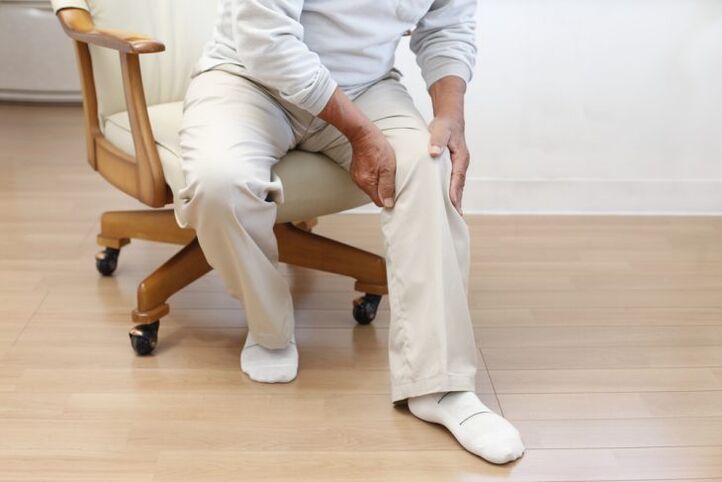Of all the joints in the human body, knee pain is the most common complaint of people. The knee joint is complex, carries a lot of load during different types of physical activity, so there can be many reasons for pain. Knee pain, even if it occasionally occurs and goes away on its own, should not go unnoticed.
Causes of Knee Pain

- Gonarthrosis or arthrosis of the knee joint. This disease is caused by excessive stress, trauma, overweight, metabolic disorders. The pain is often uncomfortable during and after physical activity, including climbing stairs, running, squatting, and gradually subsiding with rest. The painful sensations are combined with a painful snap in the joints, then swelling, deformation of the knee contours, restriction, and pain during movement. Often, and in young people, the so-called patellofemoral (patellofemoral) arthrosis occurs, when it is the joint between the patella and the articular surface of the femur that wears out.
- Damage to the menisci. The knee joint has two cartilaginous formations - the internal and external menisci, which provide better shock absorption. The inner meniscus suffers most often. It is important to know what traumatic and degenerative meniscal injuries are distinguished from. The first occurs with a sudden turn of the body, when the foot is fixed, jumping, falling. The pain is sharp, swelling in the joint develops rapidly, blood pooling in its cavity, causing swelling above the patella. The knee may not be fully extended, or the victim experiences a wedge sensation, "jumping up" from a foreign body in the joint. Degenerative meniscal tears occur mainly in elderly people with gonarthrosis. They can occur simply when walking, trying to sit on a low seat, or carrying a weight. The pain gradually increases, accompanied by swelling, synovitis (inflammatory fluid in the joint cavity). Meniscal injuries also cause pain during leg rotation (clinical tests performed by the doctor are based on this) when descending stairs.
- Damage to the ligament apparatus. More frequent trauma or associated with meniscal tears. The knee joint has the external and internal lateral ligaments, the anterior and posterior cruciate ligaments, and the patellar ligament itself. The lateral ligaments are most often affected when there is a violent deflection of the leg outward or inward on the limb axis. Cruciate ligaments are damaged when you twist the lower leg, hitting it. The ligament of the patella itself tears during its traumatic dislocation. Ligament system injuries are characterized by pain, aggravated by walking, leg support. Also, with significant damage, knee joint instability occurs in one plane or another.
- Arthritis. Inflammation of the knee joint of an infectious or non-infectious nature. The person feels constant pain that increases with exertion. The joint is swollen, dilated, hot to the touch, the skin is reddened. The general body temperature may also increase.
- Rheumatoid arthritis. It is an autoimmune disease that affects many joints, usually the knee. The pain, in this case, is of an inflammatory nature, that is, the patient complains at rest, especially after night. Movement improves blood flow and pain is relieved. Pain is accompanied by prolonged stiffness (more than half an hour). There are also other signs of inflammation in the joints: swelling, redness, an increase in the temperature of the skin above it.
- Tumors of the knee joint. Pain is not a permanent symptom of tumors. With small formations, it may not be there, as well as other signs. But if the tumor grows, affecting all the new structures in the joint, the patient begins to complain of pain. They are not associated with physical activity, being more often disturbed in the second half of the night and in the morning.
- Osteochondropathy. These are injuries to the joint surfaces. In the knee joint, Koenig's disease can occur - osteochondropathy of the inner thigh condyle, while cartilage is destroyed and its fragments can be freely located in the joint cavity, leading to an inflammatory process and joint blockage. Pain is felt during exertion, with disease development, and at rest.
Treatment
Pain is just a symptom of an illness. Its nature, location, stress dependence, time of day help, along with other symptoms, to make a preliminary diagnosis.
Treatment should be aimed primarily at eliminating a specific disease or, if this is not possible, at achieving long-term remission (a period without exacerbations), preventing progression.
Treatment methods can be conservative or surgical.
Symptomatic pain therapy is, above all, a group of medications such as non-steroidal anti-inflammatory drugs. They are used in the form of intravenous injections, intramuscular injections, tablets, capsules, rectal suppositories and topically (ointments, gels, creams, aerosols).
For many illnesses, the physician may prescribe physical methods of treatment: physical therapy procedures, dry heat or baths, semi-alcohol compresses, gentle therapeutic exercises, dressing or bracing.
This therapy, along with medications, helps to improve blood flow, relieve inflammation, and reduce pain. If the pain is associated with mechanical reasons (a part of a torn meniscus blocking a joint, a free cartilage body) or conservative therapy does not work, surgical techniques are used: joint debridement by arthroscopy, osteotomy, replacement of the knee joint with an artificial, joint closure (arthrodesis).
If you experience pain in your knee, you should see an orthopedist or traumatologist (if an injury has occurred).

























